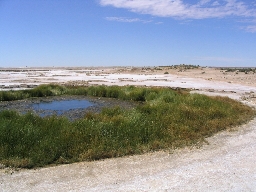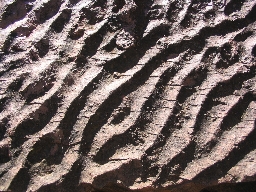|
We were excited at the prospect of seeing some mound springs, which we had
heard about. Perhaps there would even be a hot soak in some spring water. Alas, that
was not to be because the springs were look but don't touch in order to preserve
them. There are a number of springs and they are raised up on mounds which they
build themselves as they bring up hot water and minerals. They are located
around the rim of a great artesian basin and present a very strange
picture rising up in the middle of a desert.
|
 |
 |
But stranger yet is what you see when you get to the top. Amid all the
salt and mineral pans with little vegetation you suddenly find lots of
green growing in and around the spring itself. The water is hot to
touch, and these plants spend their time cooking slowly in hot very
salty and mineral water. Next on our path was a view of Lake Eyre which
usually has no water in it. This was the "Great Inland Sea" the early
European explorers believed in, except that they arrived a million
years too late. The sea had long since dried up leaving behind this
huge salt pan which occasionally gets flooded in an exceptional year.
|
|
We were lucky to see it with a little water in it...and great mirages suggesting
more water than is actually there. We originally wanted to go out on a road
to a campground but were warned off by advice that it was in terrible shape
and would wreck our vehicle. From the vehicle tracks heading out closer
to the edge in this photo you can see that some people are keen to go
closer and probably get bogged. We were happy to watch from a safe
distance.
|  |
 |
Next we came across a sign which said "Ocre Cliff". In addition to the proper brown
coloured official sign there was an old tyre propped up which was painted white
and had "Ocre Cliff" on it as well. We were familiar with the brown official
signs for scenic things, and with individuals and aboriginal communities
in the bush who stick a tyre out the front to mark an entrance. This was
the first time we had seen both. Must be important! It was. A pristine site
of great Aboriginal significance unmolested by Europeans. Incredible. |
|
So after a couple of days on the Oodnadatta track we came out on the
seal. It was late in the day and we looked for a place to camp. We
saw some interesting signs advertising camping in an abandoned town
called Farina and decided to try it out. Great camp, with hot showers
if you lit a little fire under the "donkey" to heat it. We used our
camp oven to make a stew and thought it would be good for people
to see what the flies are really like in this desert area. We wore
our fly veils much of the time. Here we are slicing up our slightly
old pumpkin to put it in the stew. Yum. At least the flies go to
sleep after dark and if you get up early you can have breakfast
before they wake up. |
 |
 |
We left the seal again after a few hundred kilometers (and an espresso coffee)
and headed out into the North Flinders and a place of legend called
Arkaroola Wilderness Park. This is a geological paradise set up by
Reg Spriggs in a very early attempt at ecotourism. We stayed there three
nights and did lots of walks plus a bit of serious 4WD work, plus a little astronomy in their
observatory. The worst
of the 4WD was done in Ark-mobiles rather than our own vehicle. Here we see
some ancient sea bed rock with the waves imprinted on it.
|
|
We were thrilled to see the endangered yellow footed wallaby on our treks.
We also saw lovely radioactive hot springs (still no hot pools to soak in), old
mines, and all sorts of other kinds of rocks rocks rocks. Old rocks. Very old
rocks. Rocks with uranium in them. Rocks with things growing on them. Rocks with
fossils. Australia is serious rock territory and Ark is an especially
fine place for seeing them.
|
 |
 |
From Ark we made our way further south calling in for overnight stays (and
hikes) in several gorges. First up was Chambers Gorge which had a rock
used for scribbling on by the original inhabitants. More seriously this
was a very fine petroglyph site. On our wanderings in Chambers Gorge
we also came across some wildlife which was slow enough to pose
for closeups.
|
|
This is a "Painted Dragon" found in this desert area. I kept taking
photographs and getting close and closer, expecting that it would
dash away at any time. But the air was cool, and the sun was warm,
and it just couldn't be bothered running into the shade under the
rocks so it waiting until I was just a few inches away.
|
 |
 |
Further back along the track we came across this Shingle Back Lizard. Don't
ask me what makes something a "dragon" or a "lizard" in common names. Dragons
sound like they should be much bigger, but this Shingle Back is about the
same size as the Painted Dragon. But as you can see it has rather different
body proportions. We saw three of these guys this day, two of them
crossing the road (slowly) in front of us. But sometimes they are a
bit too slow -- later on we saw one which had been flattened on the
road.
|











